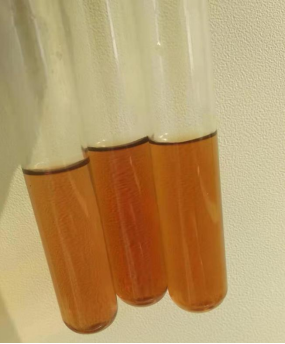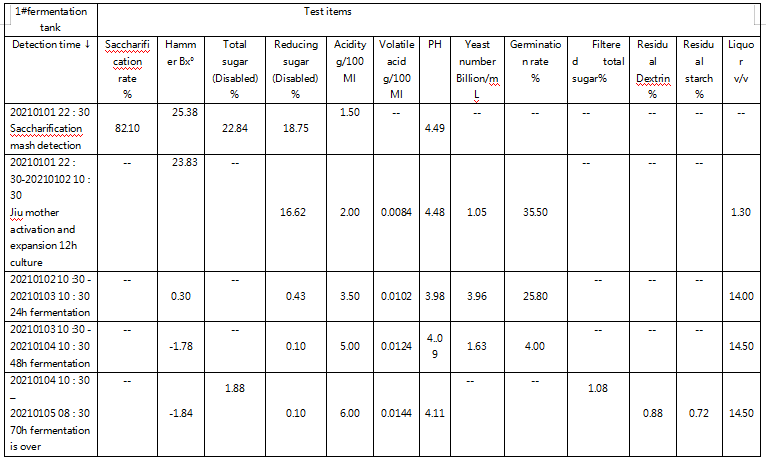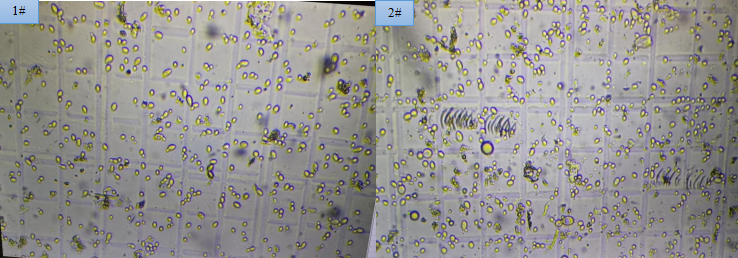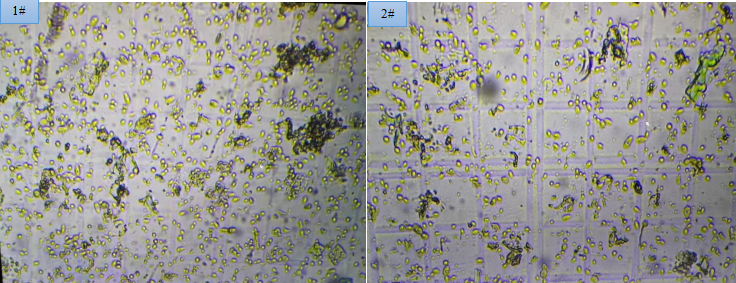
E-mail: 1309303876@qq.com
Fax: 0771-3926709
mobile : 18577822698
http://www.gxljswkj.com
Address: 601, east side, 6th floor, incubation building, Nanning science and technology business incubation base, No. 25, east section of high tech Avenue, high tech Zone, Nanning

By adding the combination of "High temperature α-amylase + compound pectinase LJSWKJ-TM10" and compound glucoamylase LJSWKJ-TM10 from Guangxi Leye Biotechnology Co., Ltd. to solve the residual starch residue caused by insufficient saccharification and liquefaction of waxy corn The problem of high precision index. At the same time, the complete conversion of waxy corn starch is achieved by adding "Le Yeast Yeast Promoter LJSWKJ-TM1 + Le Yeast Anjun Le LJSWKJ-TM5" in the alcohol fermentation process. In parallel, a control experiment of LJSWKJ-TM9, a new generation of multifunctional yeast promoter from Le Yeh, was conducted to test the product's performance in substituting urea, acid protease and penicillin.
Guo Feng 15618680995 (same number on WeChat)
Experimental report on saccharification and alcohol fermentation of waxy corn liquid in a Beihai Biomass Energy Co., Ltd.
1、Purpose
By adding the combination of "High-temperature α-amylase + LJSWKJ-TM10" and LJSWKJ-TM11 of Guangxi Leye Biotechnology Co., Ltd. to solve the problem of insufficient liquefaction and saccharification of waxy corn The problem of high residual starch and residual dextrin index. At the same time, by adding “Le Yeast Yeast Promoter LJSWKJ-TM1 + Le Yeast Anjun Le LJSWKJ-TM5” in the alcohol fermentation process, the complete conversion of waxy corn starch was realized. In parallel, Le Ye’s new generation multifunctional yeast promoter LJSWKJ-TM9 Controlled experiments to verify the product’s performance in substituting urea, acid protease and penicillin.
2、Experiment time and place
1.time
January 01, 2021-January 05, 2021, a batch.
2.location
Laboratory of Guangxi Le Yeh Biological Technology Co., Ltd.
3、Experimental equipment, raw materials and consumables
1.Experimental equipment and appliances: TY-2000 grinder, laboratory sieve (pore size 0.45cm, 40 mesh), temperature-controlled liquefaction cooking pot, BAILUN-10L two-pack fully automatic fermentation tank, ultra-clean workbench, pH meter, Analytical balance, electronic balance, microscope (electronic screen), temperature-controlled electric furnace, water bath, alcohol distillation equipment, acid-base titration equipment, brix meter, alcohol meter, glass rod, 100ml beaker, pipette, etc.
2.Raw materials and consumables: waxy corn, high-temperature α-amylase + Le Yeh compound pectinase, Le Yeh compound glucoamylase, Le Yeast dry yeast (Lesaff OEM products), Le Yeast yeast provided by COFCO Suzhou Promoter LJSWKJ-TM1, Leye bacteriostatic agent Anjunole LJSWKJ-TM5, Leye multifunctional yeast promoter LJSWKJ-TM9, acid-base standard solution and indicator, deionized water, etc.
4、Experimental steps
1.Waxy corn crush and fineness
Step 1. Weigh 5 kg of waxy corn, remove stones, ropes, corn cobs and other debris, and pulverize with a pulverizer. The pulverization rate is 61% through a 40-mesh sieve.
2.Mixing, pre-cooking and liquid saccharification.
Step 2: Weigh 2000g*2 portions of waxy corn flour, and pour them into the cooking pots numbered 1# and 2# respectively, add 4500mL of water (500mL is the evaporated water lost during the cooking process), turn on the stirring paddle and stir evenly. Stop stirring, adjust the pH to 5.9-6.0, add high temperature α-amylase + Le Yeh compound pectinase to a total of 6.89mL/pot, start the stirring and slowly raise the temperature to between 60-65°C, and keep the constant temperature for 60 minutes.
Step three, continue to heat up to 91-93°C and keep at constant temperature for 120 minutes.
①Weigh and make sure that the ratio of material to water is 1:2;
②Iodine test, the iodine test is light brown or light yellow.
Step 4. Mix the liquefied mash that has passed the iodine test and transfer it to the fermentation tanks numbered 1# and 2#, start stirring and cool to 60°C with cooling water, adjust the pH to 4.5, and add Le Yeast complex glucoamylase to each 1.31mL/tank, one hour of saccharification to detect hammerness, total sugar, reducing sugar, acidity, pH and saccharification rate. Continue to cool down to 30°C for use.
3.Dry yeast activation and inoculation.
Step 5: Weigh 0.4g*2 parts of Le Yeast dry yeast 1 hour in advance (the dry yeast inoculation amount is 0.2‰, based on the weight of waxy corn flour), and put them into two 100ml pre-sterilized and dried beakers, numbered 1#, 2#, use 30℃, 2% glucose solution to activate dry yeast for 60min.
Step 6, open the inspection holes of 1# fermenter and 2# fermenter, turn off the stirring paddle, and inoculate the activated yeast liquid (1# seed liquid corresponds to 1# fermentation tank, 2# seed liquid corresponds to 2# fermentation tank), and use four Seal the inspection hole with a layer of gauze, set a temperature of 30°C, breeze + stir (stirring paddle speed 80r/min), after 12 hours of constant temperature incubation, detect the number of yeast, germination rate, hammerness, reducing sugar, acidity, volatile acid, pH, Liquor.
4.Fermentation and testing
Step 7, close the ventilation, raise the temperature of the fermentor to 32°C, keep it at a constant temperature for 12h and then raise it to 34°C, keep it at the constant temperature for 58h until the end of the fermentation. During the period, pay attention to whether the working conditions of the regular fermenter are normal, and check the fermentation indicators every 24 hours. The detection indicators include the number of yeast and the germination rate (electron microscope photo), hammerness, total sugar, reducing sugar, acidity, volatile acid, and alcohol content.At the end of 70h fermentation, test items for filtered total sugar, residual dextrin and residual starch will be added, and various test records should be made.
5、Experimental ingredients list
Table 1 Experimental ingredients list Time:2021-01-01
Name of raw and auxiliary materials | 1# Fermentation tank addition amount | 2# Fermentation tank addition amount |
Waxy corn flour (starch content 69.87%, moisture 13.28) | 2000.00g | 2000.00g |
water | 4500.00mL (including 500mL of evaporated water) | 4500.00mL (including 500mL of evaporated water) |
High temperature α-amylase + compound pectinase | 6.89mL | 6.89mL |
Le Yeh Complex Glucoamylase | 1.31mL | 1.31mL |
Le Yeast Dry Yeast | 0.4g (0.2‰, based on the weight of waxy corn flour) | 0.4g (0.2‰, based on the weight of waxy corn flour) |
Yeast promoter LJSWKJ-TM1 | 0.4g (200g/t waxy corn flour) | do not add |
Le Yeast Anjun Le LJSWKJ-TM5 | 0.03g (5g/m³ mash) | do not add |
Urea | 3g (1500g/t waxy corn flour) | do not add |
Le Yeast Multifunctional Yeast Promoter LJSWKJ-TM9 | do not add | 0.3g (150g/t waxy corn flour) |
Detect
Table 2 Liquefied mash detection
source | Reducing sugar (%) | Dry matter (%) | DE value (reducing sugar/dry matter%) | Total sugar (%) | Iodine test (light brown) | Material to water ratio 1:2 |
Liquefied mash | Not detected | Not detected | Not detected | Not detected | Qualified (see picture below) | 1:2 qualified |

From left to right are the results of iodine test color development of 60min, 90min, and 120min of liquefied mash
Table 3 1# Fermentation tank mash mash, wine mother mash, fermentation mash detection

Table 4 2# Fermentation Tank Saccharification mash, wine mother mash, and fermentation mash detection

6、Statistics, analysis and conclusions of experimental results
1.Yeast activation and expansion 12h electron micrograph, diluted 10 times. 1# yeast number 105 million/mL, bud rate 35.5%; 2# yeast number 106 million/mL, bud rate 36.8%.

2.Electron microscope photo of fermented wine mother for 24 hours, 1# diluted 20 times, yeast number 398 million/mL, bud rate 25.8%; 2# diluted 10 times, yeast number 298 million/mL, bud rate 21.88.

3.Electron microscope photo of the wine mother after 48 hours of fermentation, diluted 10 times. 1# yeast number 163 million/mL, bud rate 4%; 2# yeast number 168 million/mL, bud rate 7%.

4.Electron microscope photo of fermented wine mother after 70h, diluted 10 times.

5.Based on the above electron microscope photos, it can be seen that the fission status of the wine mother is in good condition, the cell shape is round, full and bright, the contour of the cell wall is clear, the budding rate is high, and the number is large. This is mainly due to the addition of Le Yeast's yeast promoter to the culture medium.
6.Comprehensive iodine test color photos and Table 5 residual total sugar and residual starch indicators show that the waxy corn flour is completely liquefied and the starch residue is low.
7.According to Table 5 residual total sugar and residual dextrin, it can be seen that the saccharification index needs to be improved. The preliminary judgment is that the added amount of compound glucoamylase is low, but it may also be that the component ratio of the compound glucoamylase needs to be adjusted to make it more reasonable.
8.According to the indicators of total residual sugar, reducing sugar and alcohol content in Table 5, it can be seen that yeast has strong sugar alcohol conversion ability, fast fermentation speed and thorough fermentation.
9.According to the acidity and volatile acid indexes in Table 5, it can be seen that the bacteriostat of Le Yeast Anjunole LJSWKJ-TM5 has a good inhibitory effect on the bacteria in the alcohol fermentation process. It is recommended to continue the gradient test of the addition amount in the subsequent experiments.
10.The amount of urea added in this experiment is relatively large. Considering the pressure of downstream wastewater treatment in the large-scale production process, it can be appropriately reduced and added according to the current production situation.
11.This experiment did not test the viscosity of the liquefied mash, but according to the sensory judgment of our inspectors using a sampler to take a sample from the fermenter and filter the fermented mash, the viscosity of the mash is very low.
12.At the same time, this experiment also performed the addition experiment of the multifunctional yeast promoter newly developed by Le Yeh Company. This multifunctional yeast accelerator can completely replace the urea (or ammonium sulfate, etc.), penicillin (clementine) and acid protease in the existing process, with a small amount of addition (simplifies the process and reduces labor intensity), and the yeast fermentation speed is average throughout the process (The temperature of the fermentation tank is easy to control), the characteristics of strong post-fermentation capacity, high wine yield, and low ammonia nitrogen content in wastewater can realize a green and healthy production process of edible alcohol without resistance and salt (no antibiotics and no inorganic salt addition), but due to the current The cost is too high, so I hope to continue to cooperate with the technical department of COFCO in this field.
Guangxi Le Yeh Biological Technology Co., Ltd.
2021-01-06